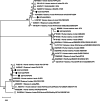Clinical and Environmental Surveillance of Rotavirus Common Genotypes Showed High Prevalence of Common P Genotypes in Egypt
- PMID: 32279222
- PMCID: PMC7224034
- DOI: 10.1007/s12560-020-09426-0
Clinical and Environmental Surveillance of Rotavirus Common Genotypes Showed High Prevalence of Common P Genotypes in Egypt
Abstract
The objective of this study was to compare the prevalence of human rotavirus group A common G and P genotypes in human Egyptian stool specimens and raw sewage samples to determine the most common genotypes for future vaccine development. From 1026 stool specimens of children with acute diarrhea and using nested RT-PCR, 250 samples (24.37%) were positive for human rotavirus group A. Using multiplex RT-PCR, rotavirus common P and G genotypes were detected as 89.20% and 46.40% of the positive clinical specimens respectively. This low percentage of common G genotypes frequency may affect the efficiency of the available live attenuated oral rotavirus vaccines [Rotarix® (human rotavirus G1P[8]) and RotaTeq® (reassortant bovine-human rotavirus G1-4P[5] and G6P[8])], however the percentage of clinical specimens which were negative for common G genotypes but positive for P[8] genotype was 12.00%. From 24 positive raw sewage samples for rotavirus group A VP6 collected from Zenin and El-Gabal El-Asfar wastewater treatment plants (WWTPs), 21 samples (87.50%) were typeable for common P genotypes while 13 samples (54.17%) were typeable for common G genotypes. Phylogenetic analysis of a VP8 partial gene of 45 P-typeable clinical isolates and 20 P-typeable raw sewage samples showed high similarity to reference strains and the majority of mutations were silent and showed lower to non-significant similarity with the two vaccine strains. This finding is useful for determining the most common antigens required for future vaccine development.
Keywords: Common P and G genotypes; Diarrhea; Human rotavirus group A; Non-silent mutation; Surveillance.
Figures







Similar articles
-
Frequency and genotyping of group A rotavirus among Egyptian children with acute gastroenteritis: a hospital-based cross-sectional study.Virol J. 2024 Sep 30;21(1):238. doi: 10.1186/s12985-024-02495-8. Virol J. 2024. PMID: 39350262 Free PMC article.
-
Epidemiological features and genetic characterization of virus strains in rotavirus associated gastroenteritis in children of Odisha in Eastern India.Infect Genet Evol. 2017 Sep;53:77-84. doi: 10.1016/j.meegid.2017.04.016. Epub 2017 Apr 22. Infect Genet Evol. 2017. PMID: 28438670
-
Sequence analysis of VP7 and VP4 genes of G1P[8] rotaviruses circulating among diarrhoeic children in Pune, India: a comparison with Rotarix and RotaTeq vaccine strains.Vaccine. 2014 Aug 11;32 Suppl 1:A75-83. doi: 10.1016/j.vaccine.2014.03.080. Vaccine. 2014. PMID: 25091685
-
Rotavirus genotypes among hospitalized children in Egypt, 2000-2002.J Infect Dis. 2010 Sep 1;202 Suppl:S263-5. doi: 10.1086/653581. J Infect Dis. 2010. PMID: 20684714
-
Molecular characterization of human group A rotavirus from stool samples in young children with diarrhea in Indonesia.Southeast Asian J Trop Med Public Health. 2010 Mar;41(2):341-6. Southeast Asian J Trop Med Public Health. 2010. PMID: 20578517
Cited by
-
Human Coronavirus NL63 Among Other Respiratory Viruses in Clinical Specimens of Egyptian Children and Raw Sewage Samples.Food Environ Virol. 2021 Sep;13(3):322-328. doi: 10.1007/s12560-021-09479-9. Epub 2021 Jun 4. Food Environ Virol. 2021. PMID: 34086254 Free PMC article.
-
Frequency and genotyping of group A rotavirus among Egyptian children with acute gastroenteritis: a hospital-based cross-sectional study.Virol J. 2024 Sep 30;21(1):238. doi: 10.1186/s12985-024-02495-8. Virol J. 2024. PMID: 39350262 Free PMC article.
-
Temporal variations of human and animal Rotavirus A genotypes in surface water used for drinking water production.Front Microbiol. 2022 Aug 9;13:912147. doi: 10.3389/fmicb.2022.912147. eCollection 2022. Front Microbiol. 2022. PMID: 36016785 Free PMC article.
-
Isolation, Propagation and Genotyping of Human Rotaviruses Circulating among Children with Gastroenteritis in Two Egyptian University Hospitals.Biology (Basel). 2022 Sep 28;11(10):1413. doi: 10.3390/biology11101413. Biology (Basel). 2022. PMID: 36290316 Free PMC article.
-
Rotavirus in Water Environments: A Systematic Review and Meta-Analysis.Environ Health Insights. 2024 Oct 18;18:11786302241276667. doi: 10.1177/11786302241276667. eCollection 2024. Environ Health Insights. 2024. PMID: 39439598 Free PMC article. Review.
References
-
- APHA (American Public Health Association) Standard methods for the examination of water and wastewater. 23. Washington, DC: American Public Health Association; 2017.
-
- Armah GE, Sow SO, Breiman RF, Dallas MJ, Tapia MD, Feikin DR, et al. Efficacy of pentavalent rotavirus vaccine against severe rotavirus gastroenteritis in infants in developing countries in sub–Saharan Africa: A randomised, double–blind, placebo–controlled trial. Lancet. 2010;376(9741):606–614. - PubMed
-
- Attoui H, Mertens PPC, Becnel J, Belaganahalli S, Bergoin M, Brussaard CP, et al. Family Reoviridae. In: King AMQ, Adams MJ, Carstens EB, Lefkowitz EJ, et al., editors. Virus taxonomy: Classification and nomenclature: Ninth report of the International Committee on Taxonomy of Viruses. San Diego, California: Elsevier Academic Press; 2012. pp. 541–637.
-
- Bányai K, László B, Duque J, Steele AD, Nelson EA, Gentsch JR, et al. Systematic review of regional and temporal trends in global rotavirus strain diversity in the pre rotavirus vaccine era: Insights for understanding the impact of rotavirus vaccination programs. Vaccine. 2012;30(1):A122–A130. - PubMed
-
- Barril PA, Fumian TM, Prez VE, Gil PI, Martínez LC, Giordano MO, et al. Rotavirus seasonality in urban sewage from Argentina: effect of meteorological variables on the viral load and the genetic diversity. Environmental Research. 2015;138:409–415. - PubMed
Publication types
MeSH terms
Substances
LinkOut - more resources
Full Text Sources
Medical

